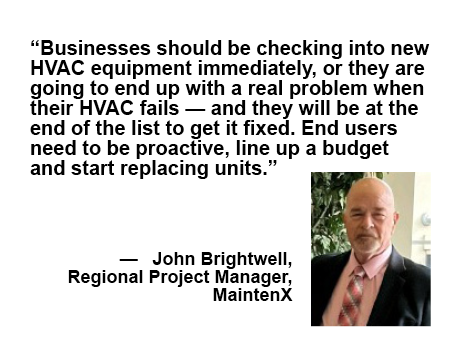An approaching shift in refrigerants for heat pumps and air-conditioning systems will have far-reaching implications for restaurant and retail operators, potentially delaying the availability of new equipment, replacement parts and access to the service providers needed to install or repair them.
“In the months before a rule change like this, everybody starts to scramble to get ready,” says John Brightwell, regional project manager at facilities repair service provider MaintenX. “We’ve budgeted for this and have adjusted our equipment, tools and training to install and service the new systems; but if an end user hasn’t planned ahead and suddenly needs to replace a failed system next year, they may struggle.”
Driving the change is a rule from the U.S. Environmental Protection Agency (EPA). Effective Jan. 1, 2025, the regulation prohibits the manufacture of air-conditioning or heat pump systems using refrigerants with a global warming potential (GWP) higher than 700.
GWP measures the potential absorption of solar radiation in the atmosphere in comparison with carbon dioxide, which has a GWP of 1. The widely used refrigerant R-410A, for example, has a GWP of 2088, so manufacturers will no longer produce systems designed for that product after this year.
Unlike the common refrigerants previously used in the United States, the new substances are slightly flammable. This requires leak detection, flushing systems and other new safety measures built into the new units, specialized training for technicians, new evacuation procedures and tool changes, all of which will increase costs for end users.
The EPA rule and updated standards published by ASHRAE allow the continued operation of existing mechanical systems using higher GWP refrigerants, but newly manufactured equipment must use the new refrigerants. Users will still be allowed to purchase and install older systems while inventories last, but sourcing replacement parts will become more difficult over time.
Retailer Considerations
How the transition will affect individual business owners will depend on the age and condition of their existing climate control systems, any prearranged service agreements for that equipment, the pace of system replacements market wide and the unpredictable occurrence of natural disasters that can exacerbate service delays and quickly deplete parts inventories.
In the first year or more following the refrigerant change, Brightwell expects his company and other HVAC technicians to have their hands full helping national retailers and other clients with largescale operations to systematically replace older units with new systems conforming to the new standard. These forward-thinking chains are among those first in line for the new 700 GWP-cooled systems as they roll out from manufacturers, Brightwell observes, so companies that expect to buy new systems in 2025 should plan for several months of lead time.
At the same time, the increasing frequency and severity of hurricanes, wildfires and other natural disasters can create surging demand for replacement systems, parts and the service providers needed to install them. Coupled with manufacturing wait times, natural disasters pose yet another potential source of delay that can leave an unprepared restaurant or retailer waiting for weeks to restore lost HVAC service.
“After a natural disaster, you may have everybody nearby trying to buy new systems at once,” Brightwell says. “The manufacturers do crank them out as fast as they can, but their plants are only so big, and it takes time to fill those orders. At one point we were waiting six months for a 5-ton split system, because the manufacturer just didn’t have them.”
Contingency Planning
Prepared restaurant owners and retailers can minimize downtime associated with HVAC failures or lost power, Brightwell says. Many businesses own emergency generators that can power their properties, and some own “spot coolers,” or portable air conditioners that can keep customers cool while waiting for an HVAC repair.
A more affordable alternative is to contract with a service provider to ensure access to leased generators or spot coolers when needed. MaintenX has a fleet of equipment on trailers in readiness for its customers, who will have first right of refusal after a disaster before the company offers those resources for lease to new clients.
Eventually, dwindling inventories of replacement parts will make older systems impractical for businesses that rely on HVAC to support their operations. For a pharmacy that must have reliable air conditioning to preserve pharmaceuticals, for example, the peace of mind that comes with a newly manufactured system may be a more immediate need than for a dry-goods retailer in a temperate climate.
That’s why Brightwell urges clients to evaluate their HVAC equipment now and begin planning how they will convert to a new-generation system, budgeting for the additional cost.
“Businesses should be checking into new HVAC equipment immediately, or they are going to end up with a real problem when their HVAC fails — and they will be at the end of the list to get it fixed,” Brightwell says. “End users need to be proactive, line up a budget and start replacing units. If they have multiple locations and can’t do them all at one time, they can just start one at a time and budget for the replacements, but they need to address the inevitable.”
— By Matt Hudgins. MaintenX is a content partner of Retail & Restaurant Facility Business. For more articles from and news about MaintenX, click here.

